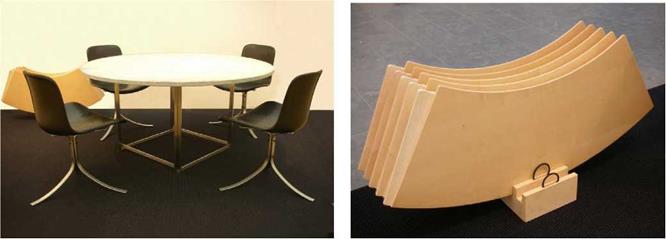Most furnishings are freestanding, but relatively few are designed to be experienced in the round. Beds, couches, case goods, and rectangular tables are often placed against a wall or next to other furnishings. Coat racks and video shelving units are typically located in corners. However, lounge seating, dining, conference, and coffee tables are designed to be experienced from multiple directions.
Finn Juhl’s leather Chieftain chair (1949), Troels Grum-Schwensen’s Waterlily seating (2003), and Poul Kjsrholm’s dining table PK 54 (1963) are designed to be experienced in the round. Juhl’s comfortable lounge is as attractive from the back as it is from the front or side. In his own modest home, the upholstered chair can be seen from all sides (Figure 3.40).
Grum-Schwensen’s Waterlily seating is a sectional module seating design that works well in a large lobby space or museum setting. Its modular nature and curvilinear form complement its versatility of use and flexibility in arrangement (Figure 3.41). The circular forms contribute to its sculptural presence, making it an ideal choice in large, open spaces. Kjsrholm’s PK 54 is an expandable circular dining table that needs sufficient space for the extensions (Figures 3.42 and 3.43). The circular flint-rolled marble table with maple wood extensions complements the orthogonal steel frame of its base, resulting in a circular and freestanding form that relates well to orthogonal elements in a room.
Inflatable
Waterbeds, inflatable air mattresses, therapy balls, and beanbag chairs are internally "filled" and externally "sheathed." The Blow armchair (Figure 3.44), designed by Jonathan de Pas, Donato d’Urbino, Paolo Lomazzi, and Massimo Scolari (1967) for Zanotta, was one of the
 first commercially produced furniture products that relied on a thin membrane of clear polyvinyl chloride (PVC), low-voltage weld-seams (using radio frequency), and air. Lightness, transparency, and low price (initially $20) contributed to the arm chair becoming an icon of the late 1960s.
first commercially produced furniture products that relied on a thin membrane of clear polyvinyl chloride (PVC), low-voltage weld-seams (using radio frequency), and air. Lightness, transparency, and low price (initially $20) contributed to the arm chair becoming an icon of the late 1960s.
Inflated therapy balls have gained popularity due to their versatility and the body movement experienced through their use. Inflated furnishings are often designed for temporary uses and can be made compact for easy storage or transport when required. Some inflated furnishings utilize heat-activated expanding gas or air-activated expanding foam, while others depend on rapid inflating and deflating techniques, cellular substructures, and integrated components designed to improve the support and experience of the user.
|
Figure 3.43 Maple extending leaves (PK 54A) for PK 54, designed by Poul Kjsrholm (1963), manufactured by Fritz Hansen. Photography by Jim Postell at the exhibition Poul Kjxrholm—Furniture Architect, curated by Michael Sheridan, with permission from Susanne Hartz, Head of Press, Louisiana Museum of Modern Art, Humlebxk, Denmark.



